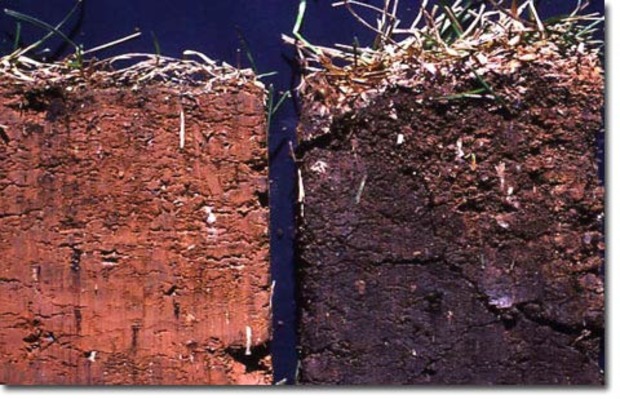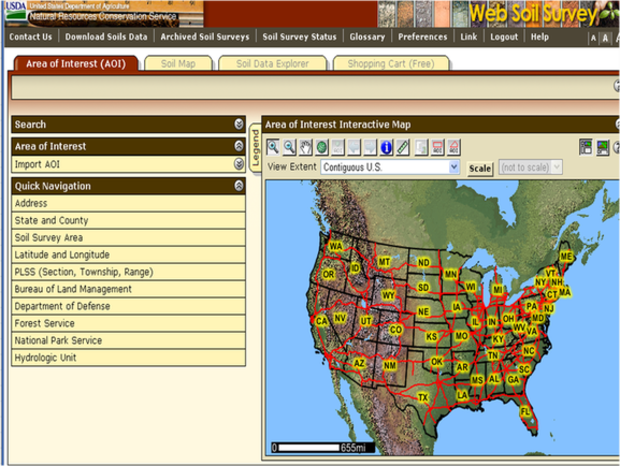
 Soil Comparison courtesy of permaculture.org
Soil Comparison courtesy of permaculture.org
Now that's a pretty presumptive title given how little I know about soil! How about this: Understanding Your Soil - From a Distance - for Beginners. Yeah, that's more like it.
There are many fantastic resources for learning about soil and I won’t pretend to be any sort of expert, but I will offer up some insight as to how we’ve gone about evaluating different properties and their soils.
As I mentioned in an earlier post on determining a farm location, we aren’t lucky enough to have land in the family or smart enough to just go pick a place and get started. Both of those options would be much easier and sometimes I envy the people that have gone down those tracks. We also don't live near the areas where we're considering buying land, so we rely on the internet for most of our research. So how can we evaluate whether a particular property will support a grass-based dairy without getting on the ground and taking a soil test?
Firstly, let's answer why soil is so important to to what we're doing.
We are committed to running as low of an input farm as we possibly can. What does this mean? It means that we don't want to import grain or fertilizers, if possible. We will rely on grass and natural forages to supply the feed for our animals. Therefore, the soil could very well be the most important factor. The soil is what nurtures the seeds and provides the nutrients for the grass to grow, and we will need a TON of grass. Well, not exactly a ton, but more like FIVE TONS... PER COW! That's almost 30 pounds per day. When I first started understanding the sheer quantity of food and water that a dairy cow intakes I was flabbergasted. I mean really, FIVE TONS of grass? Freakin' fat cows. Not only that, but in hot weather they will drink upwards of THIRTY GALLONS of water per day! I guess they weigh about a half a ton, so they kinda need to feed the inner beast. They're not only trying to pack on the pounds, but they're also supplying multiple gallons of milk every day. This means they need a high energy diet, especially if it's coming from forage alone.
Feeding cows their natural diet of 100% grass sounds like a nice idea, but it's tough to grow the high energy forage required to maintain good body condition and health of the cows. With dairy cows you can expect a lower body condition score since the milkers will literally give "the fat off their back", but you have to make sure not to compromise the health of the animal. Growing the forage to keep a dairy cow healthy and happy requires the right soil types, soil depths and nutrient levels. That's the main reason why we're spending a lot of time researching our soils.
Learning about your soil online - The Web Soil Survey
Our primary resource for soil research is the Web Soil Survey provided by the NRCS. Using the WSS is easy. From the homepage, click on the green "Start WSS" button. Once you're in the application you will see a page like this:
From here you can use the "Quick Navigation" toolbar on the left to enter the address of the property you're interested in, or you can search by state and county or any other number of elements. Once you've narrowed in on an address you'll see a close-up version of the property and the surrounding area. At this point you'll need to select an "Area of Interest". Click on one of the red AOI buttons above the map and drag it across the area that you're researching. The WSS application will "clip" the layers of soil.
Once the layers are clipped switch from the "Area of Interest" tab to the "Soil Map" tab. On this tab you'll see a map that looks like a typical topography map, only you won't see altitudes along the lines, you'll see soil type acronyms. For instance, you might see "At". Along the sidebar you'll see the soil map symbols listed with the names along the right side. "At" stands for "Atkins loam, frequently flooded". If you click on the full name a little window will pop up with all kinds of useful information. For "At" you would learn that it is poorly drained, frequently flooded, derived from sandstone/shale, has about 9.5" of water capacity and is rated a 4w class of soil. Might not be a great idea to get land with those characteristics! But now you know. For us, we can't be there during all seasons. We need all the help we can get in assessing our soils and the WSS is a great resource. If you poke around some more you can find lots of other interesting little tools on the site. You can even map out the land you're on right now.
Don't Stop There, Use Published Soil Surveys Too
The "Published Soil Surveys" by the NRCS are in many ways an even more awesome resource when used in combination with the WSS. Once you've discovered the variety of soil types on your property you can really dig in and learn more by pulling up one of the NRCS' detailed soil surveys from your county.
Head over to the list of soil surveys by state. Click on your state and find the county survey that's applicable to you. You can see along the columns if a paper copy, a CD-ROM, or an online PDF is available. For some counties the most recent survey is the early 1900's, for others it's much more recent, and for some you might not even have one. Hopefully you can find one for your area because they're really great. The first section is typically dedicated to a long history of the county. Then it moves into specific soil types and possible land uses. It goes through crop suitability, soil depth, building constraints and a whole lot more. You'll be able to do detailed research on each type of soil on your land, now that's pretty cool.
How else can you learn about your soils?
Call your local extension agent and soil specialists. This was much easier than I thought. I looked up the county extension agent online and just gave him a call. He was happy to chat with me about the research I'd already done, the conclusions I'd came to and where I might be wrong or in need of a further opinion. I was referred to ruminant specialists, dairy specialists and other experts within the extension agency and also at the NRCS. Ask all the stupid questions you want, it's the only way to learn. If you've used the WSS and the detailed surveys you'll already seem pretty smart and up-to-speed, so you really have nothing to fear, just do it.
Happy researching



